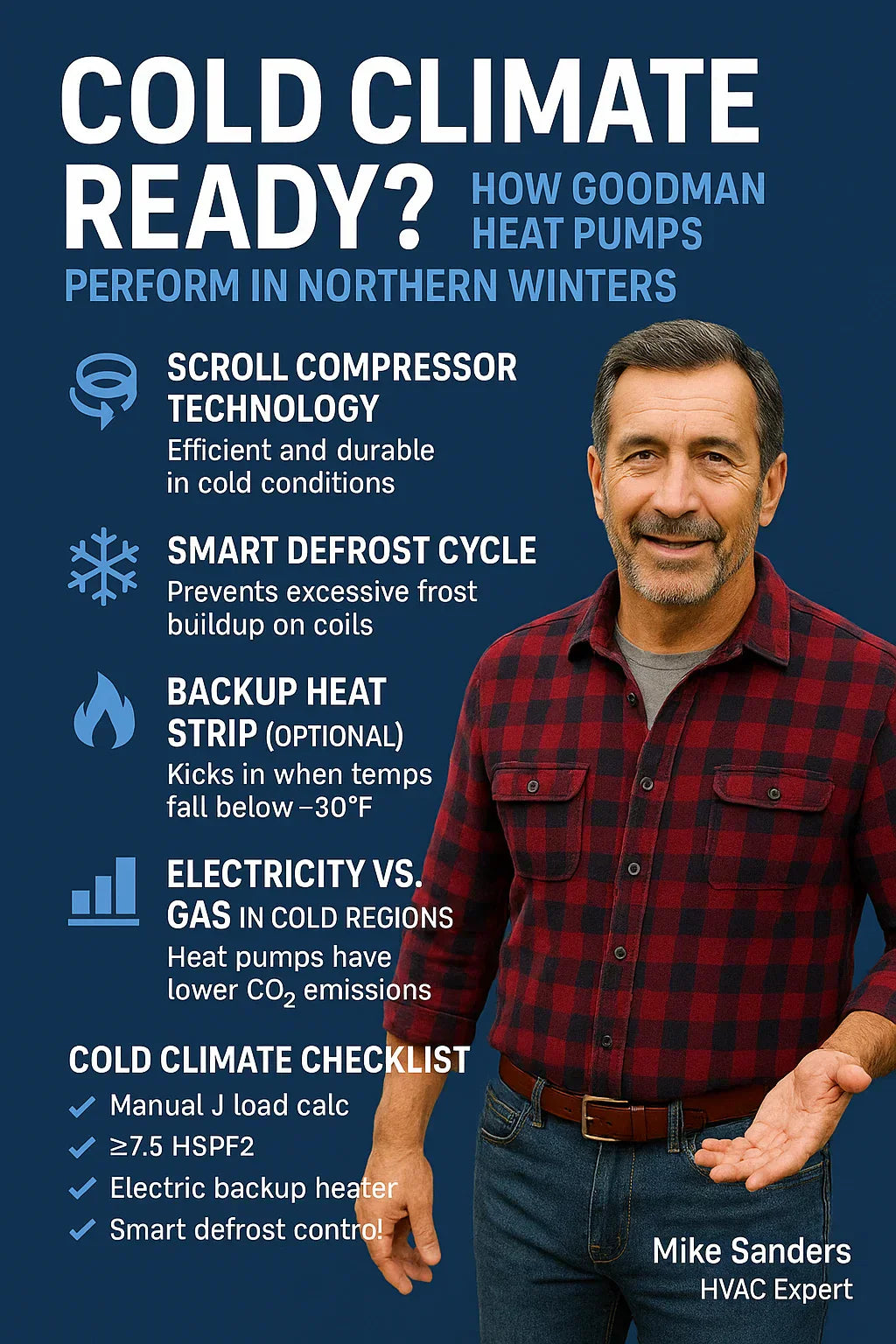By Mike Sanders, HVAC Expert
Once considered a southern-climate solution, heat pumps are now taking center stage in even the chilliest regions. With energy costs rising and electrification incentives at an all-time high, homeowners from Minnesota to Maine are asking:
“Can a Goodman heat pump handle the kind of winters we get up here?”
The answer: Yes—if it’s the right system, installed the right way.
In this deep dive, we’ll explore how Goodman heat pumps like the GLZS4BA3610 (3 Ton 15.2 SEER2) hold up in cold climates, what to look for in a winter-ready setup, and how to optimize your performance when the temperatures drop below freezing.
🧊 What Happens to Heat Pumps in Cold Weather?
Heat pumps don’t generate heat—they move it. But when the outdoor air is 20°F or below, there's less heat to extract, and performance drops.
| Temperature (°F) | Heat Pump Output |
|---|---|
| 47°F | 100% capacity |
| 30°F | ~85% capacity |
| 17°F | ~70% capacity |
| 5°F | ~50–60% capacity |
| -5°F | Backup heat needed |
💡 That’s where cold climate optimization and auxiliary heat strips come into play.
🔍 How Goodman Heat Pumps Are Built for the Cold
While not branded “cold climate heat pumps” like some variable-speed units, Goodman’s GLZS4BA3610 and similar systems do come with cold-weather engineering advantages:
🌀 Scroll Compressor Technology
Icon:🔁
-
Efficient at low speeds
-
Handles frost cycles smoothly
-
Built to withstand cold starts without strain
❄️ Smart Defrost Cycle
Icon:🌨️
-
Prevents excessive frost buildup on coils
-
Engages only when needed (sensor-controlled)
-
Reduces unnecessary energy waste
🔌 Backup Electric Heat Strip Compatibility
Icon:🔥
-
Automatically activates below ~30°F
-
Supplements or replaces heat pump output as needed
-
Works seamlessly with compatible air handlers (like AMST36CU1300)
📎 Goodman Heat Strip Kits Guide
🌬️ Multi-Speed ECM Blower in Air Handler
Icon:🌀
-
Adjusts airflow based on temperature demand
-
Helps maintain comfort even as outdoor temps fall
-
Improves dehumidification and overall efficiency
📈 SEER2 vs. HSPF2: What Efficiency Ratings Matter in the Cold?
-
SEER2 = cooling efficiency
-
HSPF2 = heating efficiency under stricter 2023 DOE test protocols
The Goodman GLZS4BA3610 earns:
-
15.2 SEER2 (excellent cooling)
-
7.8 HSPF2 (solid cold-weather heating)
🧰 Add-Ons That Improve Winter Performance
🔥 Electric Heat Strip (5–15 kW)
-
Optional add-on
-
Installed inside the air handler
-
Provides full backup heat during extreme cold snaps
🧠 Smart Thermostat Integration
-
Automates switch from heat pump to heat strip
-
Adjusts fan speed and timing for max comfort
-
Works with Goodman-compatible brands (Ecobee, Honeywell, Sensi)
🏠 Real-World Winter Performance Scenarios
🌨️ Case 1: Minneapolis, MN (Zone 6A)
-
1,900 sq ft home
-
Goodman 3 Ton GLZS4BA3610 + 10 kW backup heat
-
Electric bill Jan = ~$130
-
Indoor temps steady at 70°F
“It got down to -9°F last winter, and the house stayed warm with backup heat. Runs quieter and cheaper than our old gas furnace.”
❄️ Case 2: Buffalo, NY (Zone 5)
-
1,600 sq ft home
-
Goodman 2.5 Ton + smart thermostat
-
Outdoor temps: down to 5°F
-
System ran 70% heat pump, 30% electric assist
📌 Takeaway: Goodman systems maintain heat to ~20°F, then blend in electric strips for seamless comfort.
🔋 Energy Use Comparison: Heat Pump vs. Gas in Cold Regions
| Fuel Source | Efficiency | Cost (per MMBtu) | Environmental Impact |
|---|---|---|---|
| Natural Gas Furnace | 95% | ~$9–$11 | High CO₂ emissions |
| Heat Pump (HSPF2 7.8) | 250–300% | ~$12–$14 | All-electric, lower emissions |
| Heat Pump + Solar | 250–300% | Near $0 after install | Clean energy combo |
📎 NRDC – Heat Pumps for Cold Climates
🧠 What Makes a Heat Pump “Cold Climate Ready”?
For true performance below 17°F, look for:
-
HSPF2 ≥ 8.0
-
Variable speed inverter compressor
-
Low-ambient kit (optional with Goodman)
-
Smart defrost + demand sensors
-
Electric backup (minimum 10 kW)
⚠️ Goodman’s GLZS4BA3610 is excellent for moderate-to-cold zones, but homes in Zones 6B and 7 should consider:
-
Adding extra heat strips
-
Zoning for more control
-
Proper insulation sealing and air sealing
🛠️ Installation Best Practices for Cold Climates
| Strategy | Benefit |
|---|---|
| Mount unit off ground | Prevent snow accumulation |
| Shield condenser from wind | Improves defrost efficiency |
| Oversize slightly in cold zones | Reduces reliance on heat strips |
| Insulate line set | Prevent refrigerant loss in cold |
💸 Incentives for Cold Climate Heat Pumps
Under the Inflation Reduction Act (IRA), homeowners can claim:
-
Up to $2,000 federal tax credit
-
Additional state/local rebates (often $1,000+)
-
Performance-based programs for cold zones (e.g., NYSERDA)
📎 Climate Incentives
📎 NYSERDA Heat Pump Rebates
✅ Cold Climate Checklist for Goodman Installations
| Item | Required? |
|---|---|
| Manual J load calc | ✅ Yes |
| HSPF2 ≥ 7.5 | ✅ Yes |
| Electric heat backup | ✅ Yes |
| Line set insulation | ✅ Yes |
| Smart defrost enabled | ✅ Yes |
| Outdoor unit snow clearance | ✅ Yes |
| Smart thermostat (dual mode) | Recommended |
📋 Final Take from Mike Sanders
“You don’t need to live in Florida to benefit from a heat pump. In 2025, even Northern homeowners can stay warm and save—if the system is set up right. The Goodman GLZS4BA3610 holds its own in freezing temps, and when paired with a heat strip and smart control, it becomes a winter warrior.”
In the next topic we will read about: Is a 3 Ton Heat Pump Right for Your Home? Key Sizing Considerations.







